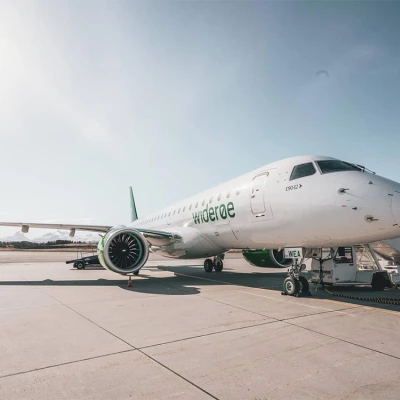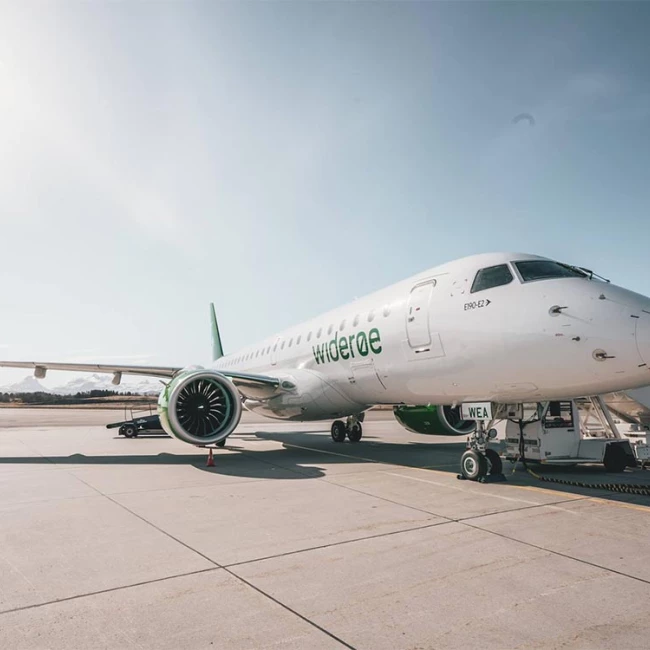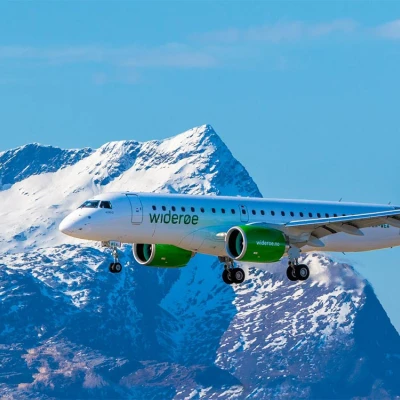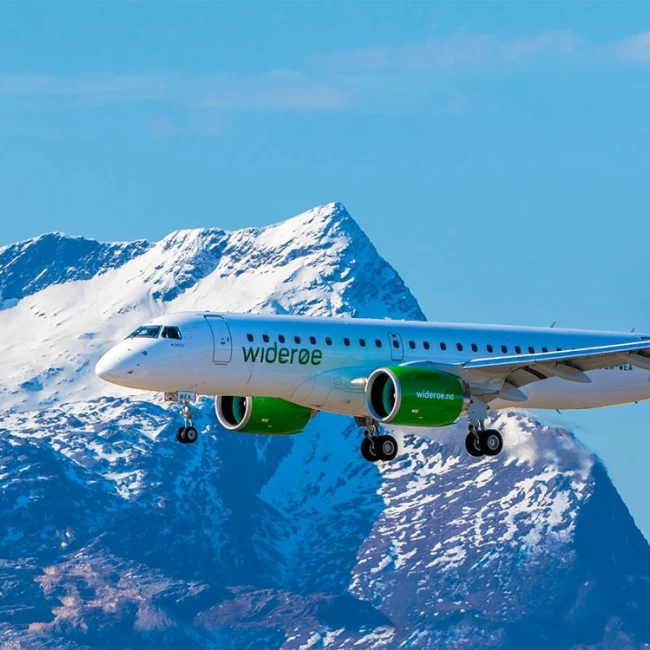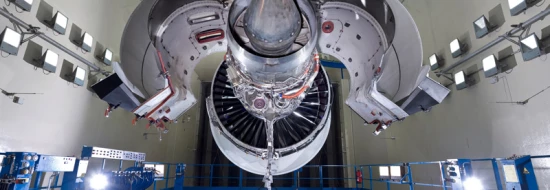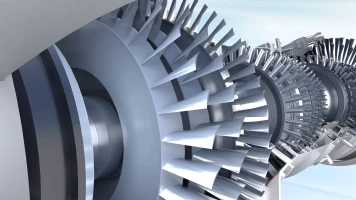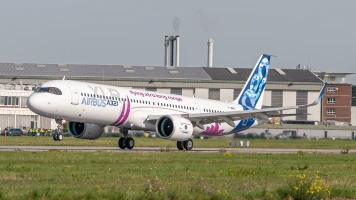aviation
Widerøe brings Norway together, now with new E2 jets
Norway is the longest country in Europe. Regional airline Widerøe is crucial to keeping the country connected. Its fleet now features new E2 jets.
08.2018 | author: Andreas Spaeth | 6 mins reading time
author:
Andreas Spaeth
has been traveling the world as a freelance aviation journalist for over 25 years, visiting and writing about airlines and airports. He is frequently invited to appear on radio and TV programs.

Norway is the land of seafaring pioneers, polar explorers and fjords—that’s its image to the world and among Norwegians themselves. Yet it is also a major country for air travel, mostly due to necessity. Measuring 2,500 kilometers from the Oslo Fjord to the Arctic Ocean bordering Russia, Norway is not only the longest country in Europe, but given the fjords and mountains that crisscross its landscape, it is also one of the most difficult to traverse by land. For a long time, the sparsely populated northern reaches in particular were virtually cut off from the capital city of Oslo and other population centers in the south. Mailboats, which used to be the only type of transportation, needed several days to travel from the arctic Finnmark down to Bergen. But Norwegian regional air service has slowly been coming into its own since 1934, when five friends joined together to found the Widerøe airline. Its planes were fitted with floats instead of landing gear, and for decades their operations were limited to places that had enough water for takeoff and landing.
From water to the sky and back
Even after World War II, Norway still had hardly any permanent airfields. For this reason, air travel first began from the water, primarily with the Noorduyn Norseman, a single-engine Canadian bush plane for ten passengers. Widerøe started its post-war service in 1949 with the Norseman before switching to the more modern DHC-3 Otter. The Otters flew in Norway until 1971; by then, enough airports were equipped with short takeoff and landing (STOL) runways that Widerøe could switch to the robust DHC-6 Twin Otter, a larger aircraft with room for 22 passengers, and do away with seaplanes altogether. The Twin Otter needs just 800 meters for takeoff or landing, and Widerøe lobbied for the construction of 19 small airports of this scale across the country. The first route was opened from Bodø in March 1967, where a Twin Otter with the call sign LN-LMN went into service as of 1968. Today, this aircraft can be seen in the Norwegian Aviation Museum in Bodø. Widerøe operated a total of 18 Twin Otters, and didn’t take the last of them out of service until 2000.
Bodø, where Widerøe has its headquarters, sits directly on the Arctic Circle and is thus no stranger to feelings of isolation: its local soccer team, as well as all other teams from the northern part of the country, was not allowed to play in the national league until 1972. The logistical hurdles for transporting the other teams there for games were simply too great. It wasn’t until the early 1970s that a network of regional airports developed to the point where air travel was possible. Since then, the northern Norwegians have been able to join the top league—both in soccer and in travel.
Same-day travel to Oslo and back for (almost) all Norwegians
Today, Norway has scheduled flights to nearly 50 domestic airports, which enable 99 percent of the population to travel from their homes all the way to Oslo and back in a single day. “There’s no other network like this in the world,” says Stein Nilsen, CEO of Widerøe, which is now Scandinavia’s largest regional airline. Its fleet of 46 aircraft flies some 2.8 million passengers annually to 46 destinations, most of them in Norway, and thus serves twice as many domestic destinations as its competitors. Over 3,000 employees help operate more than 450 flights every day. For remote villages, especially those in northern Norway, Widerøe offers a lifesaving connection to the outside world. This is reflected in the fact that 40 percent of its network consists of subsidized routes operated as a public service. “During 84 years, Widerøe has grown its network to serve nearly every airport in Norway,” Nilsen says. “And that’s not because it’s easy, but because it was important to offer transport to our customers.”
From turboprops to jets
April 24, 2018 marked the dawn of a new era for Widerøe: the Jet Age. Having ordered three Embraer E190-E2 aircraft back at the start of 2017, the airline is now the world’s first operator of this model, which was developed from the successful predecessor E-Jet series. The crucial difference lies in its new engine, the Pratt & Whitney PW1900G, which in the E2 is attached to a completely new kind of wing. As a result, the E2 is over 17 percent more fuel-efficient than its predecessor.
“The E190-E2 represents a big step for Widerøe,” says Nilsen. “We need more capacity on longer routes, such as from Bergen to Tromsø or Bodø. These are currently flown with the Bombardier Q400, which takes two and a half hours. With the E2 we can do it in under two hours while increasing capacity from 78 to 114 seats.” The new aircraft is also giving Widerøe the boost it needs to expand to Germany for the first time: since August, the Norwegian airline has been flying its new E2 jets nonstop from Bergen to Hamburg and Munich. However, Nilsen says that the company wants to “remain under the radar of the completion and out of their markets”—in other words, not get in the way of SAS or Norwegian.
Return to Brazil
For Widerøe, this marks a return to Embraer: from 1992 to 1998, their fleet had three Embraer turboprop planes, the 30-seat EMB 120 Brasilia. “It is a pleasure to be, one again, part of the Embraer family,” Nilsen said upon taking delivery of the first new aircraft at the manufacturing plant in São José dos Campos near São Paulo. And since the launch of the three E2 jets went so well, Widerøe can imagine going even further: “We’ll have to come back here and see if we can be the launch customer of the E175-E2,” said Nilsen—a statement enthusiastically received by Embraer and suppliers in South America.
One of Norway’s highlights is its fjords, which stretch along almost the entire 25,000 kilometers of the country’s coastline.









